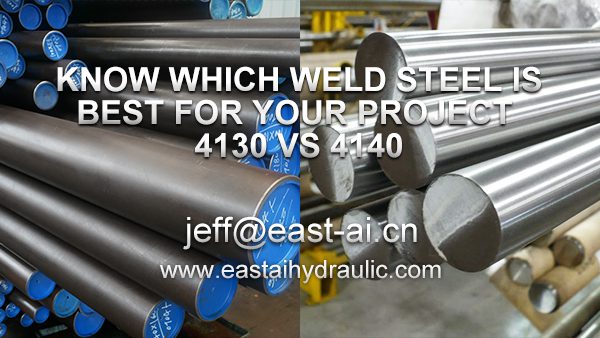When you’re dealing with heavy equipment applications—like fabricating and repairing shafts, gears, and forgings—choosing the right material is crucial. AISI/SAE 4130 and 4140 low-alloy steels are top contenders for these demanding tasks due to their ability to be heat treated to achieve high tensile strength and hardness.
AlSl 4140 steelVS 4130 Steel chemical composition
| C | Si | Mn | S | P | Cr | Mo | |
| AISI 4140 | 0.38~0.43 | 0.15~0.35 | 0.75~1.00 | ≤0.035 | ≤0.040 | 0.80~1.10 | 0.15~0.25 |
| AlSI 4130 | 0.28~0.33 | 0.15~0.35 | 0.40~0.60 | ≤0.035 | ≤0.040 | 0.80~1.10 | 0.15~0.25 |
AISl 4140 VS 4130 Steel mechanical behavior (mechanical properties)
The mechanical properties of AISI 4140 steel VS 4130 Steel are outlined in the following table.
| AISI SAE 4140 Stee | AISI SAE 4130 Steel | ||
| Properties (behavior) | Metric | Properties (behavior) | Metric |
| Tensile strength,Uitimate | 655 MPa | Tensile strength,Uitimate | 560 MPa |
| Tensile strength,Yield | 415 MPa | Tensile strength, Yield | 460 MPa |
| Modulus of elasticity | 190-210 MPa | Modulus of elasticity | 190-210 MPa |
| Bulk modulus | 140 GPa | Bulk modulus | 140 GPa |
| Shear modulus | 80 GP² | Shear modulus | 80 GPa 0.27-0.30 |
| Poisson ratio | 0.27-0.30 | Poisson ratio | |
| Elongation at break (in 50 mm) | 25.7% | Elongation at break (in 50 mm) | 21.5% |
| Reduction of area | 45 | Reduction of area | 59.6 |
| Hardness,Brinell (Annealing) | 217 Max | Hardness,Brinell (Annealing) | 217 Max |
| Hardness,Rockwell C(Q+T) | 22 | Hardness,Rockwell C (Q+T) | 22 |
Chemical Composition and Differences
The AISI/SAE 4130 and 4140 specifications focus solely on the chemical composition, not the mechanical properties. Both steels are alloyed with carbon, chromium (0.80 to 1.15 percent), and molybdenum (0.15 to 0.25 percent). The main difference between them lies in their carbon content—4130 contains a nominal 0.3 percent carbon, while 4140 has a nominal 0.4 percent.
Impact of Thermal Treatment
The strength of both 4130 and 4140 steels can vary significantly depending on the thermal treatment applied. Common treatments include annealing, normalizing, and quenching and tempering. Flame hardening can also be employed to harden the outer surface while maintaining a relatively soft interior.
Challenges and Best Practices for Welding 4130 and 4140 Steels
Welding 4130 and 4140 steels presents unique challenges due to their high carbon, chromium, and molybdenum content, which can make them more susceptible to cracking. Whether you’re welding new material or performing repair work, following these six steps will help ensure success.
Identify Thermal Treatment
When working with new materials, they are typically in the annealed or normalized condition. It’s advisable to avoid welding 4130 or 4140 steels in the quench and tempered or case-hardened states without first annealing or normalizing the area to be welded.
Select the Right Filler Metal
Choosing the proper filler metal depends on the material’s condition before welding, the design requirements, and the desired post-weld condition. Typically, a low-alloy filler metal that doesn’t match the 4130/4140 base material’s composition is used, but it must provide suitable mechanical properties. Avoid overmatching the tensile strength of the base metal, as this can lead to reduced ductility and increased crack susceptibility.
Apply Preheat
Given the higher hardenability of these steels, preheating is essential. This process slows the cooling rate and helps prevent the formation of brittle microstructures. Ensure consistent preheating by achieving temperatures between 550 to 800 degrees Fahrenheit throughout the entire thickness of the material.
Perform Welding
Managing heat input is crucial. Insufficient heat can accelerate cooling, leading to brittle microstructures that reduce ductility and toughness. Adjust voltage, amperage, and travel speed to achieve the optimal welding conditions.
Slow Cooling
After welding, maintain the preheat temperature for some time to allow for the diffusion of hydrogen from the weld metal and the heat-affected zone (HAZ). This «hydrogen bake-out» process reduces the risk of cracking.
Apply Post-Weld Thermal Treatment
Post-weld heat treatment relieves stresses that can lead to cracking and helps maintain tight tolerances. This is particularly important for thicker materials, which typically require stress relief at 1,050 to 1,250 degrees Fahrenheit for about an hour per inch of thickness.
Tips for Repairing 4130 and 4140 Steels
Repairing these steels can be more complex than working with new materials, especially if the component is worn, greasy, or dirty. It’s essential to gather as much information as possible about the material’s prior thermal treatment.
Crack Repair
Crack repair is challenging due to higher joint restraint, which increases the risk of cracking. Start by performing dye-penetrant (PT) or magnetic particle (MT) inspection to identify the full extent of the crack. Completely remove the cracked area and use preheat during any arc-gouging process to reduce further cracking risks.
Build-Up and Overlay
Restoring components to their original dimensions or applying a hard overlay requires careful selection of build-up and overlay filler metals. Overlay products are typically harder but have thickness limitations, while build-up products are better for restoring dimensions beyond what an overlay product can handle.
Closing Thoughts
The high hardenability of 4130 and 4140 steels means that filler metal selection, hydrogen control, and cooling rate are critical for achieving the best welding results. To ensure success in heavy equipment welding applications, always verify design requirements, choose the appropriate filler metal, manage heat input carefully, and apply the correct thermal treatments before and after welding.


